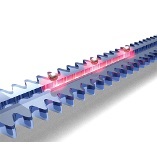03 April 2017
Photonic crystals are periodic dielectric structures in which the propagation of light can differ significantly from uniform media. Photonic band gaps in these structures, frequency ranges where light is forbidden to propagate due to strong destructive interference, are predicted to yield novel interactions between atoms coupled to such structures. In particular, an excited atom within the bandgap cannot spontaneously emit, but instead, a localized atom-photon bound state forms, the photonic component of which can facilitate spin interactions or exert strong forces on proximal atoms. This phenomenon results in strong spin-dependent potentials, where the internal states of atoms dictate the inter-atomic forces. An interesting question, then, is whether such a system can support “quantum crystals,” in which entanglement or other spin correlations are responsible for spatial ordering.
In a recent study published in Nature Communications, ICFO researchers Marco T. Manzoni led by Nest Professor at ICFO Darrick Chang, in collaboration with Ludwig Mathey from University of Hamburg, propose and analyze a realistic experimental setup where strongly correlated many-body states of atomic spin and motion can emerge. In a one-dimensional photonic crystal waveguide with short-range interactions, they find a rich phase diagram of emergent orders, including spatially dimerized spin-entangled pairs, a fluid of composite particles comprised of joint spin-phonon excitations, and a fractional magnetization plateau associated with trimer formation.
The results of their work suggest that spin-motion coupling can be a dominant phenomenon in all hybrid systems of atoms and photonic crystals, and hint at the possibility of creating and studying exotic quantum materials that have not existed before.

Interfacing cold atoms and photonic crystals
Spin-motion coupling as a dominant phenomenon in hybrid systems of atoms and photonic crystals in Nature Communications.

Interfacing cold atoms and photonic crystals













